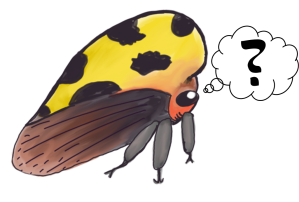Written by Joe Ballenger
So this is a fantastic question, especially if you’re trying to shed those extra pounds after Thanksgiving and Christmas.
So do bugs get fat?
Yeah, they do. Sometimes it’s adorable, and sometimes it’s…not.
Back in the 1960s, Winifred Doane, an entomologist working in Nigeria found a fly which was really fat. It’s not the kind of thing which would normally stand out to folks, but a chubby fly is kind of a cool find.
The flies were fat because they were deficient in a protein called WTDC1, which turns off the pathway which results in fat accumulation. Without WTDC1, the flies simply can’t stop accumulating fat.
We have this gene, too, and it appears to be at least somewhat involved in problems with weight gain. Interestingly, WTDC1 is part of a pathway which acts on histone proteins-the ones which hold on to DNA when it’s not being used-and works to allow certain genes to be made when they’re needed. This is called epigenetic regulation, and it’s something we’re just beginning to understand half a century after the discovery of this gene.
Insects get fat for very much the same reason people do. It’s a mixture of genetics, diet, even the bacteria which live inside the insect. If you feed the insect a high calorie diet, either sugar or fat, they’re going to get fat just like a person. The same principles-even the same molecules-work for insects.

When an insect eats, nutrients get absorbed by the gut. The gut transfers the fat to a protein called apolipophorin. Because fat doesn’t dissolve in water, it needs a helper to shuttle the protein through the blood. In fact, we use an identical protein to do this. Eventually, the fat ends up in an organ called the fat body.
This fat body is a really cool organ, because it works as both fat tissue and liver.
The fat body is one of the few organs which is situated throughout the entire insect’s body. Because of that, it allows the organ to act like a sensor for everything that’s going on.
So let’s take a look at a detoxification pathway, shall we?
Since I’m writing this on Jan 1, the day everyone in the country is fighting a hangover, let’s take a look at how insects detoxify alcohol!
Flies get drunk, too
Fruit flies live in rotting fruit, and alcohol is a common byproduct of the decomposition process in sugary materials. As a result, they have to deal with alcohol as a part of everyday life.
Fruit flies can get drunk, in much the same way people do. At low doses, they stumble around and get discoordinated. At higher doses, they pass out. Just like in humans, high alcohol consumption will result in memory loss. Male flies will get drunk after they’re rejected from mating attempts, and they can even get addicted to alcohol. Just like many of us on the day after New Year’s, they will go through withdrawl after a drinking binge and get a hangover.
All the pathways used in humans are there, and work exactly the same way. We can use flies as a model to understand addiction in humans, but also use alcohol to understand how insects detoxify chemicals. It’s funny, but also really important.
So, before we continue, I need to tell you about what one of my friends does during New Year’s.
Every year she has a party, she closes off the room with a baby gate. If someone can’t walk over the gate without tripping on it, she takes your keys because you’re not good to drive. It’s a drunk-test of sorts.
Entomologists have a similar device called an inebriometer. It functions as a drunk-test for fruit flies. If they have trouble passing through the device, they’re absolutely sauced. We can study the effects of various genes by knocking them out, or overexpressing them, and testing the ability of flies to navigate this device.

Alcohol does a number of things inside the flies. For example, when they’re parasitized by wasps, they tend to seek out food which has a higher alcohol content. They’re looking for about 6%, about as much as you’d get in a beer.
When they seek out alcohol, it’s not the alcohol which kills the wasps. Alcohol activates two pathways called the Toll and IMD pathways. These are pathways which fight infection, and their activiation ends up killing the wasps through expression of proteins which nestle into the cell membranes and pop the cells like a balloon. Presumably, they use this to counteract the mechanisms parasites use to knock out the immune system, but this only seems to work on female wasp larvae.
Drosophila breaks alcohol down the same way we do, turning ethanol into acetaldehyde and eventually into vinegar using alcohol dehydrogenase. It’s actually the buildup of acetaldehyde which results in a hangover.
Alcohol dehydrogenase is expressed in the fat body, and the malpighian tubules, as are the rest of the enzymes insects use to break down pesticides and toxic substances found in food. Typically there’s a sensor which turns the pathway on and a whole cascade of biochemical events which leads to the enzymes being produced and activated. The fat body, because it surrounds the blood, is in a really good position to be able to sense what’s in the blood. Because of that, that’s where these detox pathways are situated.
Alcohol dehydrogenase is an extremely well characterized enzyme, but as far as I can tell, we don’t know much about those sensors which turn it on.
The Bottom Line
The fat body is probably the most interesting organ in the insect’s body. It’s where nutrients are stored, and where the energy they need comes from when it’s time to migrate. Most of the stuff that insects are famous for, even the social structure of honeybees, revolve around this organ in one way or another.
It’s a hub because it’s important in nutritional signaling. When a caterpillar molts, the fat body will tell the brain what the developmental situation is like. When a mosquito wants to produce eggs, those proteins come from the fat body. It’s not unlike our own adipose tissue or our pancreas.
The fat body is one of two organs in the insect’s body which touches pretty much all the blood at once. The other is the Malpighian tubules, which are also really important to detox because of their large surface area. Both of these organs act in concert to help keep the insect safe from toxic chemicals.
Sometimes that’s useful, sometimes it’s not. Either way, the fat body is the organ which keeps most entomologists employed.
Works Cited
Park, A., Ghezzi, A., Wijesekera, T. P., & Atkinson, N. S. (2017). Genetics and genomics of alcohol responses in Drosophila. Neuropharmacology, 122, 22-35.
Musselman, L. P., & Kühnlein, R. P. (2018). Drosophila as a model to study obesity and metabolic disease. Journal of Experimental Biology, 221(Suppl 1).
Troutwine, B. R., Ghezzi, A., Pietrzykowski, A. Z., & Atkinson, N. S. (2016). Alcohol resistance in Drosophila is modulated by the Toll innate immune pathway. Genes, Brain and Behavior, 15(4), 382-394



A really cute article; congratulations and thanks.
A remark: like in insects, human fat generally is spread throughout the body, and is often referred to as the “adipose organ” and, in many people, it is the body’s largest organ. Mind you, things aren’t so simple, as not all the body’s fat tissue has quite the same function or nature, and I bet the same is true in insects.
Also, there is an interesting resemblance between fat in mammals and fat in insects as a means of fighting some kinds of invasion: fat seems to be important as a component of the human immune system.
LikeLike